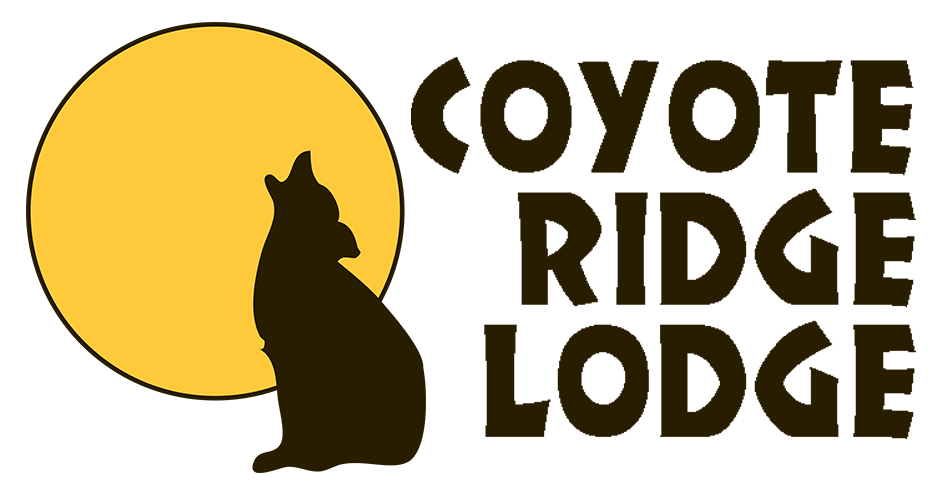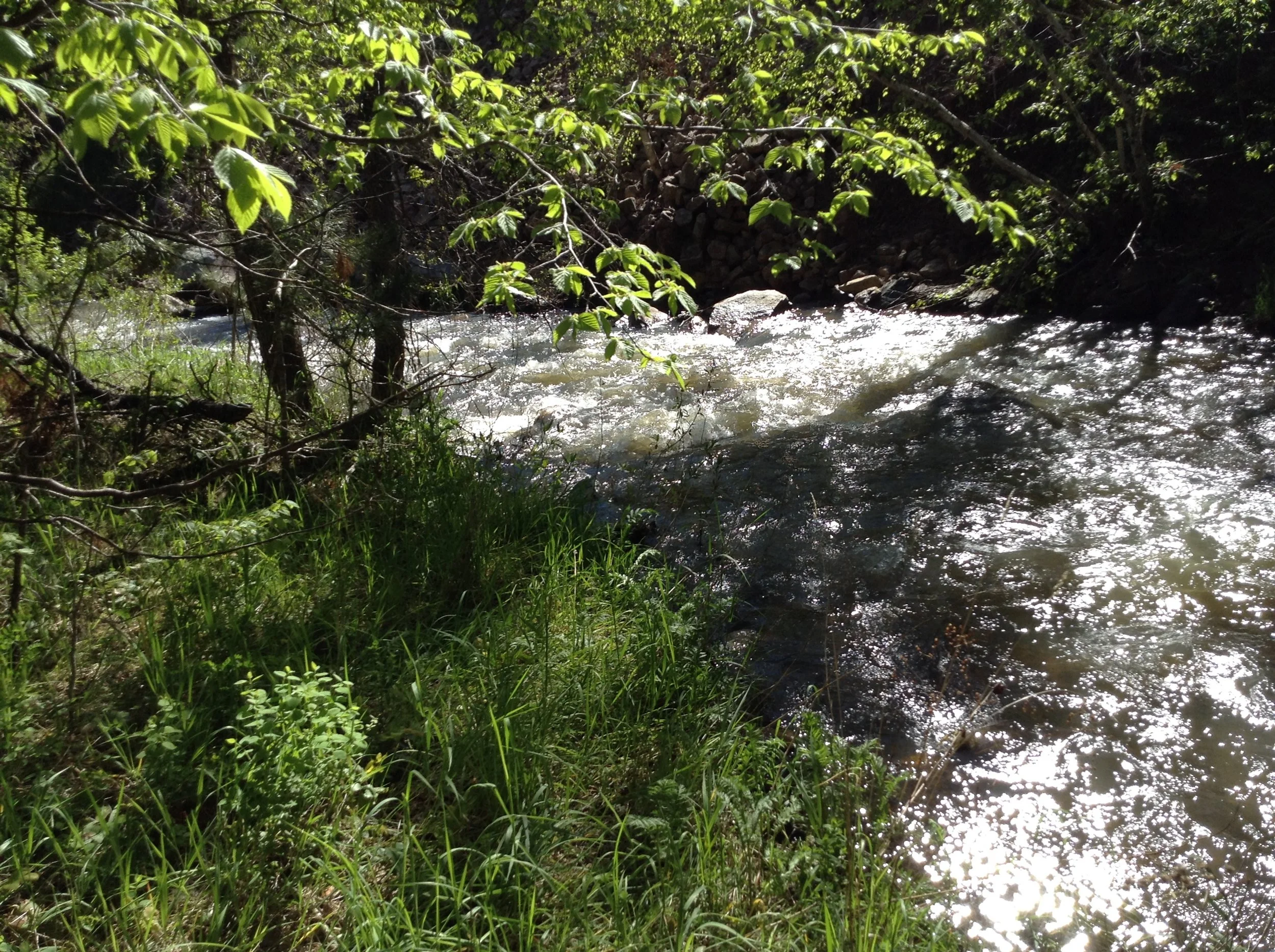Coyote Ridge Lodge History
Kids on The deck, around 1999
A short history of the wooden house
by Al Gunther
I started work on Coyote Ridge Lodge, with a shovel and an old steel-wheeled wheelbarrow, in July of 1978. I was on a tight budget; most of my equipment, old used tools and lumber (and 50 lbs of pinto beans), came from farm auctions. [I was teaching at Black Hills State College. I quickly fell in love with the Northern Hills and the prairie and Spearfish, so I got the idea to build a house. I paid $11,000 for this 10-acre parcel of creek, meadow and woods; had to borrow half of it from the bank.]
I didn’t know much about building design and had zero carpenter skills. But I found a good US Forest Service book about wood-frame house construction and a good friend, Tony Goodson, who taught me the thousand things you can never find in books – how to pull a really stuck nail, or how to level a 30-ft foundation with a length of plastic hose and some water.
Parking area Sign
It was mostly a locally sourced project. Almost all the lumber came from Harry Jeffrey’s homemade sawmill just two miles down the road. He ran the saw, in his barn, from the power take-off on his tractor. Many of the original windows I fashioned from discarded storm windows I found in Spearfish. The walnut floor was made (laboriously) out of scrap wood from a salad-bowl factory in Hermosa. I designed the house on blue-lined graph paper – the kind you use in a high school geometry class. I started with a clerestory roof, also known as a “hog shed” roof (the offset roof ridge makes for easy ventilation in the heat of summer) and then added the big bay. The original cabin was just the big main room and the loft.
I moved in around the end of October of 1978. Had electricity, but just a canvas flap for a front door and an outhouse up the hill (the original outhouse door is mounted on the woodshed). I hauled water from town, 250 gallons per load, in a tank on the back of my beloved 1950 Chevy half-ton farm truck (I bought that truck for $400 from a Belle Fourche junk yard. How I wish I still had it). Stored the water in a big galvanized stock tank in the basement. Got it to the kitchen by priming and cranking a hand pump next to the sink. Showers? I bought a Holiday Inn pool membership in town and stopped in there 3-4 times a week with a towel.
For years the Fisher wood-burning stove was my only source of heat. Well, also the sun. When the sun is shining through all the south-facing windows the house will stay warm into the evening on the coldest days of winter. Upgrades came slowly. Drilled a well, shared with the neighbors, when we could finally afford it. It goes 600 feet deep into the Madison aquifer. Added the back room, bathroom and laundry room in 1982. The bunkhouse started out as a little sauna building but soon turned into a storage shed and sometime winter lodging for squirrels.
Wheelbarrow and Woodshed
It was a nice life; had a lovable, frisky dog, some cats, lots of wildlife around. Interesting too. In deep winter snow I had to hike up to the house pulling groceries in a sled. In spring, False-Bottom Creek would sometimes flood so I’d miss a day or two of work. Spearfish was a lively little town. I had an interesting job – teaching journalism – at the college, and I had good friends.
But in 1982 I took a sabbatical and went off to Stanford, in California, to work on a PhD in journalism and communication. I came back for a few weeks each summer, but mostly the cabin was rented. Good friends and neighbors took care of maintenance and periodic upgrades. Years of wandering followed. I ended up with a good teaching and research job at the University of Wisconsin in Madison, three great kids, and a busy life. The cabin housed a succession of renters, some better than others. Life got more complicated. I spent some years overseas and visited the cabin less and less often.
The place, however, had a deep, psychic grip on my soul. I rarely thought of it in my daily life, but often had vivid dreams about it.
False-Bottom Creek
By 2013 I had decided to sell it. I drove out from Wisconsin to fix it up (the cabin was in poor shape, neglected, abused). For two weeks I repaired furniture, refinished the floor, painted the porch, picked up beer cans in the woods. I took some walks and smelled the sweet butterscotch scent of the big Ponderosa pines. I watched, when the air stirred even slightly, the quaking dance of Aspen leaves below the driveway. At night I’d sit on the deck, drink some wine, look for shooting stars, listen to the burbling creek and sometimes hear the coyotes’ song. I thought back to those visits when my kids were little – they would come through the door (they call it the wooden house) and look at me with big eyes and say “You built this, dad?”
Then came that slap-yourself-on-the-forehead moment: “What am I thinking? I can’t sell this place.”
Coyote Ridge Lodge became a vacation rental and a joyful, ongoing project. Why didn’t I think of this sooner? The house cleaners, and most renters, keep it in great condition. Guests have been amazingly clean, respectful, even thankful. Virtually everyone who stays here seems to love it for the same reasons I do, something that gives me almost as much pleasure and satisfaction as being here myself (which I do now about three times a year). Perhaps best of all, it’s still a work in progress….
So if you have any ideas for improvements, I’d love to hear them. But most of all I hope you are having a wonderful stay and that, some night, you hear the coyotes singing on the ridge.
Al Gunther
Madison, Wisconsin
June, 2017




